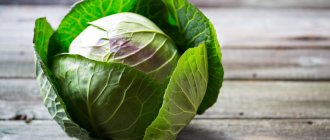It is difficult to organize long-term storage of cabbage in a city apartment. A small volume of vegetables can even be placed in the refrigerator if everything is organized correctly.
Several methods are suitable for this, allowing you to save even chopped or defective vegetables.
We will tell you in the article how to properly and in what form (fresh, stewed, cut, etc.) it is best to store cabbage in the refrigerator, how long the shelf life is and how to extend it.
A little about cabbage
Cabbage was considered the main vegetable in Europe before the potato was discovered. It does not apply to overseas vegetables. The past of cabbage is very bright and rich. She was even depicted on ancient paintings. This vegetable began its journey from Ancient Greece and then spread throughout Europe. Cabbage dishes are present in any European national cuisine.
Cabbage contains a lot of protein, much more than other vegetables. Proteins are considered essential amino acids. They are necessary for the growth and reconstruction of tissue, the thyroid gland, adrenal glands and kidneys, and hematopoiesis.
Cabbage has a long shelf life, so the vitamins it contains can be preserved until the next harvest. This vegetable contains an attractive vitamin U, with the help of which colitis, intestinal sluggishness and gastritis, duodenal and stomach ulcers are treated. It contains no less vitamin C than citrus fruits. And vitamin K heals wounds, normalizes metabolism, forms healthy teeth and bones, and helps the liver function.
Nutritionists recommend eating sauerkraut, as it is considered extremely healthy.
Cabbage after expiration date
If cabbage or dishes containing it are stored in inappropriate conditions, there is a high risk of spoilage. For cabbage they are:
- The leaves dry out or turn black;
- Slugs are found in the cabbage;
- The head of cabbage may look normal, but inside it is affected by rot;
- Change in color and smell.
Vegetables with these and other signs of spoilage are not recommended for consumption.
As for dishes with cabbage, in case of spoilage:
- An unpleasant odor appears;
- Mold and slime may form.
We do not recommend consuming expired food. If you experience discomfort after eating foods containing cabbage, consult your doctor.
Saving conditions
What are the storage periods and conditions for white cabbage? This vegetable can be stored for 4 to 5 months in suitable conditions. The best temperature is considered to be from -1 to 0 °C, stable air humidity should be 90-95%.
If cabbage is stored at above-zero temperatures, then the air moisture content should be 80-85%. During storage, you need to occasionally check the vegetable and remove spoiled leaves. If you wrap the cabbages tightly in newsprint, they can be kept in a cool, dry area. They need to be placed at a short distance from each other.
The lifespan of cabbage depends on the storage conditions and its variety. Whatever storage method you choose, it is recommended to leave the stalks longer.
Balcony as storage for vegetables
The main disadvantage of storing vegetables in the refrigerator is that there is not enough space. Even the most spacious can accommodate no more than ten heads of cabbage. In addition, there are other products that are placed in vegetable chambers. A loggia or balcony can be a salvation if they are glazed and sufficiently insulated.
Storing cabbage on the balcony is a great option. You couldn't find a better place in the apartment. Typically, a lockable cabinet with shelving is installed for these purposes. The heads of cabbage are wrapped in paper or cling film and placed in one row so that there is a small space between the forks. Newspapers should not be used as they contain ink containing harmful substances. Another rule is that you cannot store cabbage on the balcony in winter if the air temperature on the balcony drops to sub-zero values.
You need to check vegetables monthly and remove forks that show signs of rotting. In the spring, such a check should be carried out weekly, or more often. Beijing, as well as Romanesco and broccoli cannot be stored on the balcony. This cabbage here will quickly become unusable due to temperature changes.
How to store in the refrigerator?
Few people know how to store cabbage in the refrigerator. Due to the low temperatures, this method of preserving it is considered the most optimal. Cabbage can be stored in cold conditions for a very long time. In this case, it is only important to protect it from moisture. We invite you to learn some small tricks:
- It is preferable to store cabbage in plastic on the top shelf of the refrigerator, since the real cold reigns there.
- Choose springy heads with strong leaves as they store better.
- Send only dry heads of cabbage for storage. You need to wrap them tightly with cellophane in 2-3 layers, leaving no air spaces between the leaves and the film.
- Before saving, cut off damaged areas and dents, cut off the stalk so that it is flush with the leaves.
If you prevent water from getting on the surface of the cabbage, it can remain fresh in the refrigerator for a long time. If you wrap cabbage in cellophane, it will be stored in the refrigerator for 20-30 days; without film, it can only last 2-3 days in such conditions.
Preparing cabbage for storage
In order for cabbage to be stored for a long time, you need to put some effort into the process of harvesting it.
- Sort the cabbage carefully: only mature, dense heads of cabbage without cracks, mechanical damage, mold, rot or signs of disease can survive the winter fresh.
- When cutting, be sure to leave the head of cabbage a small part of the stalk (up to 3 cm) and a couple of strong covering leaves.
- Harvest in dry weather, and dry the cut cabbage for 24 hours in a warm, well-ventilated place.
- Do not rush to harvest: wait until the daytime temperature drops to 3-8°C, and the night temperature to almost 0°C, and only then take the sharpest knife and go to the garden for cabbage.
In the freezer
We continue to figure out how to store cabbage in the refrigerator. Can white cabbage be frozen? When choosing this storage method, you need to remember that frozen cabbage is used only for some types of dishes. The benefits of freezing are:
- ready semi-finished product;
- fast defrosting;
- storage duration;
- preserving the healing qualities of the vegetable.
The disadvantages of freezing are:
- slight loss of the primary appearance;
- the vegetable loses its crunch.
Shelf life of Chinese cabbage
Cookbooks from Asian countries and beyond require that dishes contain Chinese cabbage. To ensure that the ingredient pleases with its taste and juiciness, quality standards offer the following storage conditions:
- For late varieties - in the refrigerator, at a temperature from 0 to +2 degrees, for no more than 30 days;
- For early varieties - under similar storage conditions no more than 2 weeks;
- Regardless of the variety - in the freezer, down to -18 degrees for no more than six months from the date of purchase;
- At room temperature – from 12 to 24 hours.
We do not recommend storing Chinese cabbage at temperatures above +5 degrees. Please note that heads of cabbage that ripen in mid-autumn are best suited for long-term storage.
How to freeze?
How to store cabbage in the refrigerator or freezer? You can freeze the vegetable in small pieces, whole heads of cabbage and pre-chopped ones. When freezing cabbage in pieces, you need to peel the top leaves, rinse, cut off the stalk, and divide into pieces. If you are storing leaves, boil them and dry them in advance. Next, the finished portions are placed in containers or bags and sent to the freezer.
Do you want to freeze whole heads of cabbage? Choose only undamaged, healthy vegetables, free from insects. Then remove the top leaves from the cabbage, rinse it with water and dry it. The head of cabbage can be wrapped in cellophane and then placed in the freezer.
Many people ask: “Can cabbage be stored in the refrigerator?” Yes, of course you can. Shredded cabbage is the most popular way to save. The vegetable needs to be washed and cleaned of damage and top layers, chopped, placed in bags and placed in the freezer.
How long can cabbage be stored in the refrigerator or freezer? The vegetable can stay there for 9 to 12 months at a temperature not higher than -18 °C.
Preparing the head of cabbage
For storage you need to select small, dense forks. If you bought them late in the fall, then it is most likely a late cabbage variety suitable for long-term storage.
You should avoid storing cabbage of other ripening periods, as well as loose heads of late varieties. Such specimens can last no more than 3 months without damage.
The preliminary preparation of vegetables is of great importance in selecting forks for storage. All forks are thoroughly inspected and, if cracks, signs of damage from pests, or dents from transportation are found, they are rejected and used for their intended purpose as quickly as possible.
The remaining stems must be trimmed. The shorter it is, the better for effective storage. From the remains of the stems, cabbage during storage may produce flower stalks or small heads of cabbage, which will have a bad effect on the quality of storage.
Important! Before storage, the forks should be freed from the outer leaves, leaving no more than one pair of leaves. During storage, these leaves will protect the heads of cabbage from fungal and bacterial infections.
In addition, the heads of cabbage are washed in running water. By this method, harmful insects, particles of earth and sand are washed out of the forks. At the end of the preparatory work, all forks are wiped with clean cloth rags to remove all moisture. Dried heads can be stored.
Storage at home temperature
The issue of storing cabbage at home interests many. After all, not every thrifty person has a cellar. What if there is no refrigerator? Room temperature is far from the best condition for preserving cabbage. In this case, the vegetable will quickly lose its appearance and deteriorate, so its shelf life is significantly reduced.
At home, you can save cabbage on a well-insulated balcony or in a pantry. The vegetable can be left unchanged, or it can be wrapped in paper or plastic to protect it from external influences.
When storing in this way, do not place the forks tightly together; there should be a small distance between them to ensure air circulation. At home temperature, the shelf life of cabbage is 4-6 months. The temperature should not be higher than +15 °C.
But in the cellar cabbage (late varieties) can last from 6 to 7 months. Early varieties can be stored for no more than 3 months.
Recommendations
Expert advice on storing cabbage in the refrigerator will help you deal with the issue as efficiently as possible:
When planning to stock up on vegetables, you should take into account the amount of free space in the refrigerator that can be allocated for cabbage.- If you need to store vegetables for a long time, until spring, then the refrigerator will not help with this. The exception is freezing.
- The shelf life of a head of cabbage with defects or with cut sections is significantly less than that of whole ones.
- Wet heads of white cabbage should not be placed in the refrigerator without first drying them.
- If the vegetable is already frozen, it will not be stored.
- Fresh cabbage is best stored in the refrigerator whole, not cut.
- The duration of storage of fresh heads of cabbage depends not only on the conditions, but also on the type of vegetable. Early and mid-ripening ones last less in the refrigerator than late-ripening ones.
- Substandard specimens can be used for preservation and stewing.
- You can freeze not only shredded cabbage, but also separated into individual leaves, if the preparation is intended for preparing cabbage rolls. After thawing, these leaves become soft and pliable—pre-boiling is no longer required.
- Exceeding the storage temperature can lead to rapid rotting of the heads of cabbage.
When choosing a location for a significant amount of cabbage, it is best to give preference to the cellar rather than the refrigerator.
Harvesting cauliflower
How to store cauliflower in the refrigerator? This vegetable is the second most popular species grown in Russia. Of course, white cabbage takes first place. An important point in preserving cauliflower is the time it is harvested. It is important to remember several canons here:
- The heads need to be collected while they are still growing. When their diameter reaches 8-12 cm, the weight will be approximately 300-1200 g. If the vegetable is overripe, it will lose most of its taste and beneficial properties. Such a plant will be crumbly and yellowed.
- During harvesting, cauliflower must be carefully cut with a knife, leaving 2-4 leaves. If it has shoots, you can try to grow new inflorescences. To do this, leave a couple of strong shoots and eliminate the rest. You need to care for the vegetable in the same way as with simple planting.
- Do not leave cut heads in direct sunlight. Otherwise they will turn yellow and cannot be eaten.
How to grow cabbage for storage
Storing fresh cabbage in winter is only possible if it has been properly grown. After all, the composition of the soil, fertilizers applied to the soil, and even autumn rains can change the keeping quality of heads of cabbage for the worse.
- Everything about sowing, growing and feeding cabbage (in tables)
Several handy tables that will tell you how to care for cabbage all season long.
However, although growing cabbage has many subtleties, the following can be considered the most important:
- cabbage grown on light or loamy soils lasts longer;
- a large amount of nitrogen fertilizers reduces the keeping quality of cabbage, while potassium-phosphorus fertilizers, on the contrary, increase them;
- an abundance of autumn precipitation or excessive uneven watering leads to cracking of the heads of cabbage, and they will not be stored;
- Premature harvesting will not allow vegetables to ripen; if they are unripe, they will not last even a couple of months.
Cauliflower in the refrigerator
If you decide to store cauliflower in the refrigerator, first remove the leaves and roots and then place it in a plastic bag. One head must be in one package. You can wrap cauliflower heads in plastic. Unfortunately, this option will extend the life of the vegetable by only a week.
It should be noted that in a cellar at 0 °C and 95% humidity, cauliflower can be stored for up to seven weeks. It just needs to be placed in polymer or wooden boxes and covered with cling film. In a suspended state at the same air humidity and temperature, cauliflower can be stored for up to three weeks.
Adviсe
Experienced housewives, when preparing forks for storage, recommend performing the following actions:
- Soak each head of cabbage in salt water before putting it in the refrigerator. 20 minutes will be enough for this.
- Then dry the heads of cabbage with a waffle towel. This technique can rid the vegetable of insects stuck between the leaves.
- Inspect stored vegetables regularly. If you notice that cabbage leaves have lost their usual color, remove them from the refrigerator and remove wrappers and spoiling leaves.
- After that, wrap the fork in film again and put it in the refrigerator.
If fresh cabbage loses its original appearance, you can take it out of the refrigerator and ferment or preserve it.
As you can see, you can store cabbage forks for a long time in small quantities even in a city apartment. Having a refrigerator, this problem will not be difficult to solve. Conduct experiments, try different options to determine the best one.
Freezing cauliflower
Freezing is the longest and most reliable way to preserve cauliflower. Of course, this is not a fresh vegetable, but you can eat delicious dishes for at least six months.
You can freeze either lightly cooked cabbage or fresh cabbage. First, the heads should be washed and disassembled into smaller inflorescences. Then drain the water and dry the cabbage. The method for boiling (blanching) cabbage is the same as for kohlrabi.
Cauliflower prepared in this way can be stored for 6 to 12 months in a separate bag in the freezer.
Where is the best place to place it?
In modern refrigerators, vegetables are stored in the freshness zone. This is the name given to the special space between the freezer and refrigerator compartment. The temperature here is maintained at about 3-4 degrees Celsius, as well as high humidity. These are optimal conditions for preserving vegetables, including cabbage.
If there is no such zone, the heads of cabbage are placed in the compartment with vegetables and covered with a lid on top. It is opened periodically to provide fresh air.
The freshness zone is specially designed for vegetables and fruits
Saving other types of cabbage
Peking cabbage at home can only be stored in the refrigerator. It needs to be wrapped in cellophane and sent to the vegetable department. You can also store kohlrabi cabbage in the refrigerator. However, she is not able to lie like that all winter. This type of cabbage “goes stale” very quickly, so it has a minimal fresh shelf life.
Broccoli can only be stored in the refrigerator for a very short time, and its storage method is not the same as others. It is forbidden to wash broccoli before placing it in the refrigerator; it is better to do this immediately before use. In this case, follow these steps:
- Place each unit in a separate bag. Don't close it.
- Place a damp cloth in the bottom of the vegetable drawer in the refrigerator.
- Place opened bags of broccoli on a cloth.
This creates increased humidity in the storage area, allowing the broccoli to last longer. Remember that storing cabbage in the refrigerator, wrapped in plastic, is the most reliable way, and at home temperature it is the most carefree.
Kohlrabi can be stored in the refrigerator for about a month, Chinese cabbage and broccoli - for a maximum of 15 days. Frozen cabbage of any type can be stored for up to 10 months, and dried cabbage for up to 12 months.
To keep cabbage in polyethylene longer, check for condensation inside the film. If droplets of water appear between the cellophane and the head of cabbage, change the cling film. To do this, you need to unwrap the cabbage, throw away the plastic, dry the cabbage and wrap it in new film. Do this every time condensation appears.
The best cabbage varieties for storage
Preparation for storing cabbage begins at the seed selection stage. Not all cabbage is suitable for fresh wintering - early and mid-season varieties do not last even until December. It’s good to pamper yourself with them in the summer or early autumn, but for pickling and winter storage, mid-late and late-ripening varieties are suitable, as well as those whose seed packaging is marked “for storage.”
The following mid-late cabbage varieties are suitable for storage: Belorusskaya 455, Dobrovolskaya, Vyuga, Podarok, Rusinovka. Of the late-ripening varieties, the most popular are: Amager 611, Snow White, Stone Head, Kamenka, Morozko. Their dense heads of cabbage are resistant to rot, are easily stored for 8-10 months and only become tastier over time.
- The best varieties and hybrids of late cabbage for winter storage and pickling
What varieties and hybrids can be stored for many months and are suitable for pickling? See our selection.











